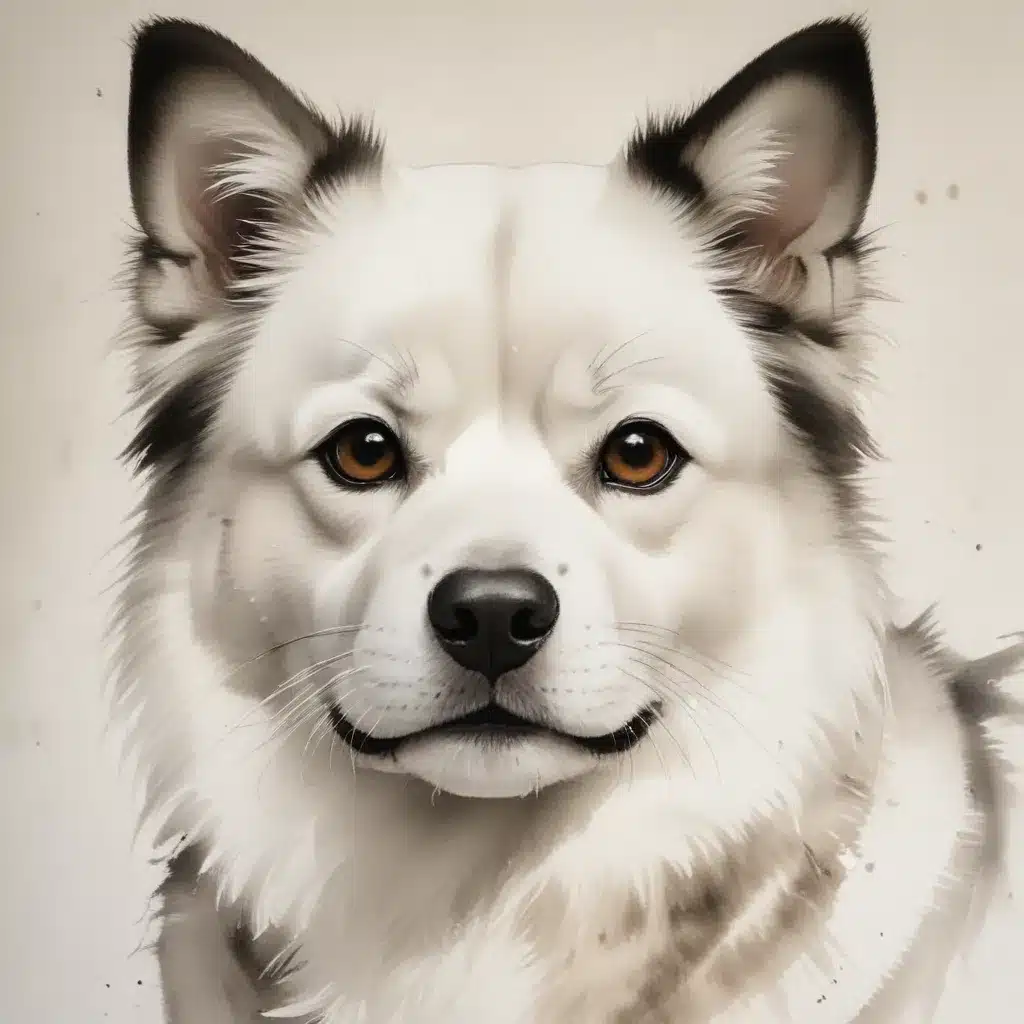
The delicate, minimalist brushwork of sumi-e (also known as suibokuga, or ‘ink wash painting’) offers a captivating approach to pet portraiture, allowing artists to capture the essence of their four-legged subjects with elegant simplicity. Originating in China during the Tang Dynasty (618-907 AD) and later refined in Japan, this traditional East Asian ink painting technique has a profound connection to the philosophies of Zen Buddhism, emphasizing spontaneity, harmony with nature, and the expression of a subject’s inner spirit.
The Essence of Sumi-e Painting
At the heart of sumi-e is the mastery of the brush stroke. Artists must learn to control the flow of black ink, using varied tonal ranges, brushwork textures, and strategic composition to convey the true nature of their subject. Rather than aiming for photorealistic detail, sumi-e painters strive to distill the essence of their subject, whether it be a majestic landscape, a delicate flower, or the playful spirit of a beloved pet.
The minimalist aesthetic of sumi-e painting allows the artist’s personal expression to shine through. By skillfully manipulating the flow of ink on the absorbent rice paper or silk, they can suggest form, texture, and mood with just a few decisive strokes. The interplay of positive and negative space is crucial, as the untouched areas of the paper become an integral part of the composition, evoking a sense of serenity and balance.
The History and Influence of Sumi-e
The origins of sumi-e can be traced back to the development of Chinese calligraphy, where the mastery of the brush was paramount. During the Song Dynasty (960-1279 AD), the art form began to evolve, with Zen Buddhist monks playing a pivotal role in its refinement and dissemination. One of the most influential figures was the Zen monk and painter Sesshū Tōyō (1420-1506), whose work exemplified the spontaneous, expressive qualities of sumi-e.
As sumi-e spread to Japan, it became closely intertwined with Zen philosophy, with practitioners using the meditative process of painting as a means of self-expression and spiritual cultivation. The art form flourished during the Muromachi period (1336-1573), inspiring countless artists and scholars to explore the depths of this unique visual language.
Today, the enduring appeal of sumi-e can be seen in its influence on various artistic disciplines, from calligraphy and East Asian brush painting to contemporary art and design. Its timeless elegance and ability to evoke profound emotions with seemingly simple brushstrokes continue to captivate artists and art enthusiasts alike.
Sumi-e Painting and Pet Portraits
The intrinsic connection between sumi-e and the natural world makes it a particularly compelling medium for pet portraiture. The minimalist aesthetic and focus on capturing the essence of the subject lend themselves well to the unique personalities and movements of our furry, feathered, or scaled companions.
Unique Challenges of Sumi-e Pet Portraiture
Translating the dynamic forms and textures of a pet into the sumi-e style presents its own set of challenges. The dense, directional fur of animals like dogs and cats, for example, requires a delicate balance of brushwork and ink-blending to convey their soft, fluffy appearance. Capturing the grace and agility of a leaping cat or the regal bearing of a proud hound demands a keen understanding of animal anatomy and the ability to distill those forms into the essential brush strokes.
The Sumi-e Pet Portrait Aesthetic
Despite these technical hurdles, the sumi-e approach to pet portraiture can yield captivating results. By emphasizing the expressive movement and emotive qualities of their subjects, artists can create portraits that transcend mere likeness and instead evoke the unique character of the pet. The strategic use of negative space and the interplay of bold, gestural strokes and delicate ink washes can imbue the painting with a sense of liveliness and spontaneity, mirroring the energy and personality of the animal.
The Enduring Appeal of Sumi-e Pet Portraits
As the popularity of pet portraiture continues to grow, the timeless elegance and cultural significance of sumi-e have made it an increasingly sought-after medium for discerning pet owners and art enthusiasts alike. The intersection of this traditional East Asian art form and the beloved subject of pets has resulted in a unique and visually captivating genre that celebrates the deep bond between humans and their animal companions.
Capturing the Essence of the Pet-Owner Relationship
Beyond simply depicting the physical likeness of a pet, sumi-e pet portraits have the power to capture the essence of the pet-owner relationship. The minimalist approach and focus on emotional expression allow artists to convey the affection, playfulness, or even the quiet contemplation shared between a person and their beloved animal friend. These paintings become treasured keepsakes, preserving the unique spirit of the pet and the cherished memories associated with them.
The Growing Popularity of Sumi-e Pet Art
As more pet owners discover the beauty and significance of sumi-e painting, the demand for this art form has steadily increased. Artists who specialize in sumi-e pet portraiture have found a receptive audience among those seeking to commemorate their pets in a timeless, meaningful way. The fusion of traditional East Asian aesthetics and the enduring love for our animal companions has created a niche that continues to inspire and delight art enthusiasts and pet lovers alike.
Whether you are an aspiring artist exploring the captivating world of sumi-e or a pet owner seeking a unique way to honor your furry, feathered, or scaled companion, the art of sumi-e offers a profoundly enriching and visually stunning approach to pet portraiture. By embracing the essence of this ancient East Asian tradition, you can create works of art that not only celebrate the beauty of your pet but also touch the heart with their timeless elegance and emotional resonance.